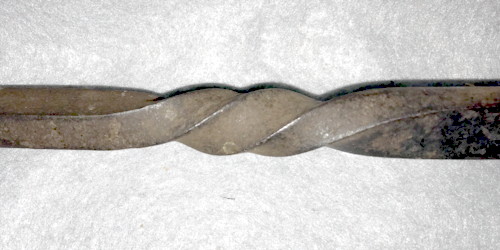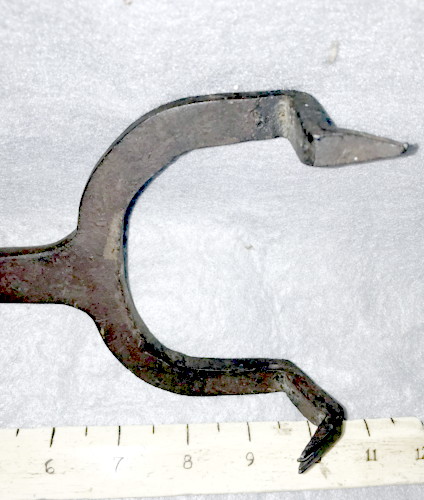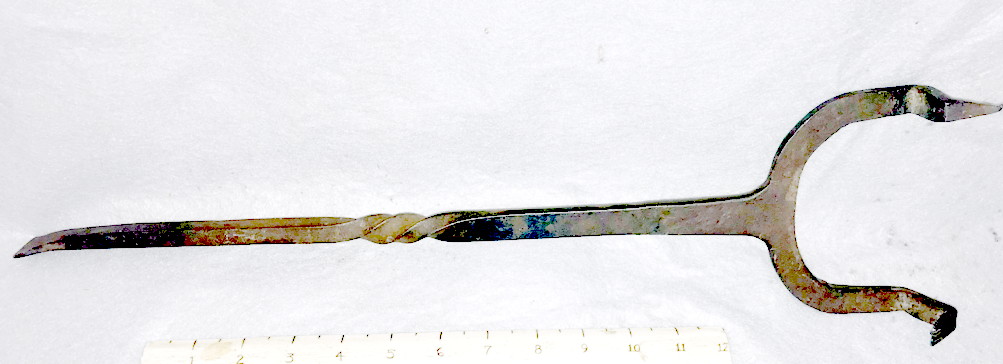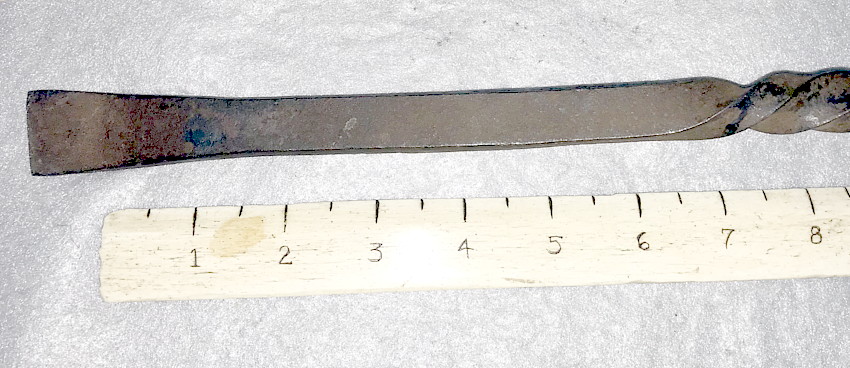Item NA19 - Early Hand Wrought Cooper’s
Flagging Iron

 Most
people today don’t recognize this cooper’s tool, but in the days of whaling or
other trades where “wet” barrels were likely to develop leaks from rough seas or
cartage, this was an essential tool. It was used to partially disassemble a
leaking barrel so that caulking material could be inserted between leaking
staves—or more often between the heads of heads of the staves and the the cask
head, in the croze. The caulking material used were the dried blades of
rushes—bulrushes, thule rushes, blue and yellow flags (hence the name “flagging
iron”). The tool is basically a lever, with four or five points of leverage.
After loosening the emptied cask by knocking down the upper and middle hoops,
the flagging iron is used to pry the head away from the croze so that the
suspect staves can be loosened. The flagging iron is then used to pry the top
of the suspect stave away from its peers so that a strip of flagging can be
inserted in the gap (or in the croze groove at its top.). The cooper, holding
the flagging iron with his hip, can insert the rush, and twisting it to increase
the thickness of the caulk, then releases the lever. Then after trimming the
flagging material, the hoops are pounded back into their positions and the tight
cask can then be refilled,
Most
people today don’t recognize this cooper’s tool, but in the days of whaling or
other trades where “wet” barrels were likely to develop leaks from rough seas or
cartage, this was an essential tool. It was used to partially disassemble a
leaking barrel so that caulking material could be inserted between leaking
staves—or more often between the heads of heads of the staves and the the cask
head, in the croze. The caulking material used were the dried blades of
rushes—bulrushes, thule rushes, blue and yellow flags (hence the name “flagging
iron”). The tool is basically a lever, with four or five points of leverage.
After loosening the emptied cask by knocking down the upper and middle hoops,
the flagging iron is used to pry the head away from the croze so that the
suspect staves can be loosened. The flagging iron is then used to pry the top
of the suspect stave away from its peers so that a strip of flagging can be
inserted in the gap (or in the croze groove at its top.). The cooper, holding
the flagging iron with his hip, can insert the rush, and twisting it to increase
the thickness of the caulk, then releases the lever. Then after trimming the
flagging material, the hoops are pounded back into their positions and the tight
cask can then be refilled,
This flagging iron is, by far, the nicest one that I’ve seen. Made of a bar of
wrought iron, that is 5/8” x 3/8” it is about 20” long. It has a single
spatulate prying end at its base. The other end is formed into a broad fork,
the two tines of which are bent and re-bent into two other prying tips (one
filed into a flat serrated tip for prying staves apart, and the other s a single
sharp point for cleaning out old caulking. These two tips are angled in
opposite directions, with one tip braced against outside of a stave while the
other is brought against the inside of the neighboring stave so the two staves
can be levered apart while the flagging is inserted. It is a great example of a
one-piece multi-tool!
Additional features not usually seen in these tool include a decorative twist
given to the main pry bar. Also the maker (or owner) of this tool signed in by
dimpling his name “Harvey” in the iron just above the twist. The name is formed
of capital block letters, each formed of two rows of dimples. In style and
versatility this iron is vastly superior to later and lesser versions of this
type of tool. Fine.


Price -
$145.00
RETURN to forsale list.